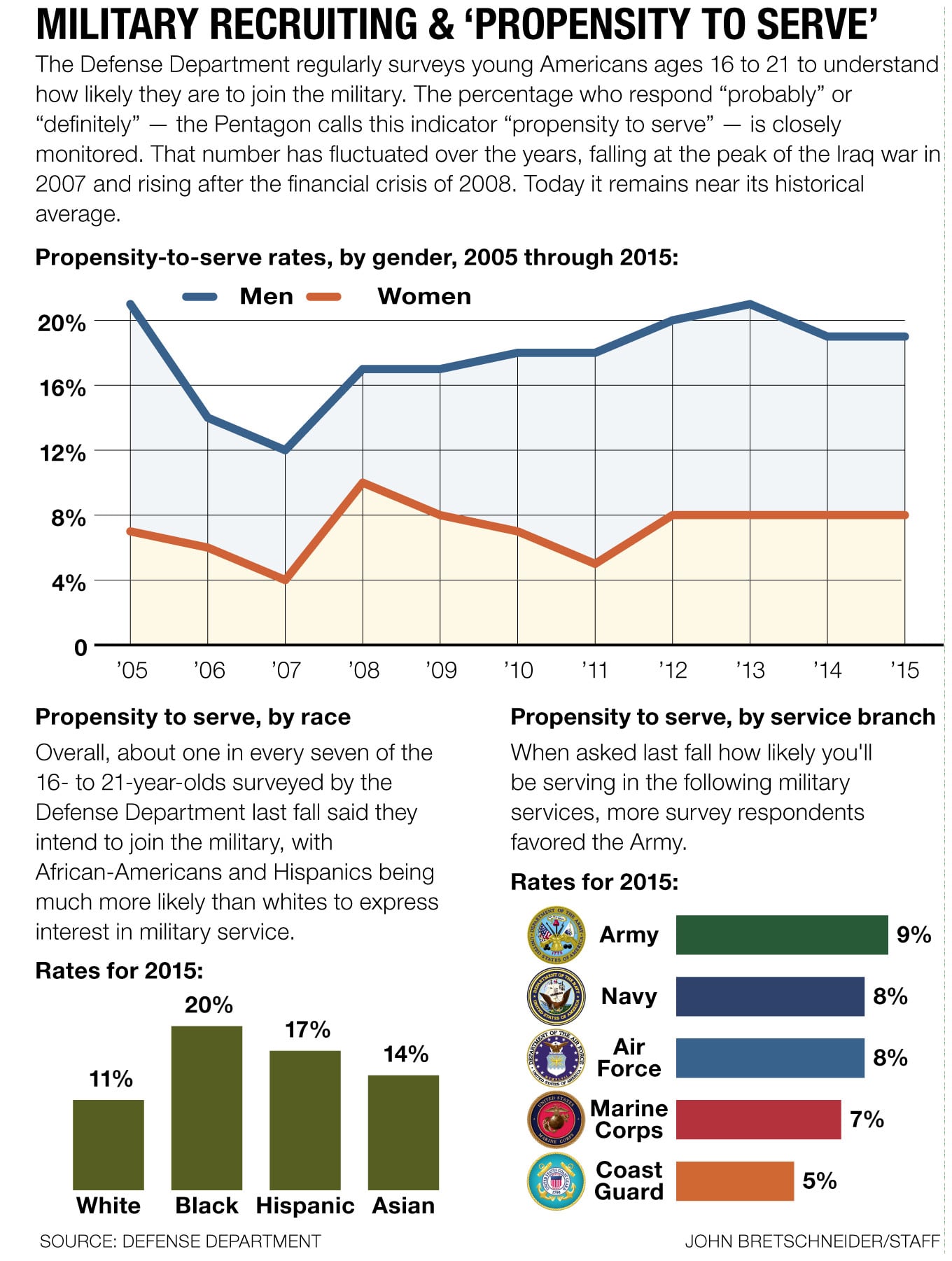Young Americans Today’s military recruiting market remains strong and young people show continue to show steady interest in military service serving in the rank-and-file military force despite the improved a steadily improving economy and the fading sense of patriotic duty that can be traced directly to accompanied the the "9/11 generation," according to an analysis of Defense Department data conducted by Military Times shows.
In fact, internal Pentagon polls that routinely tracks public opinion among the military’s target demographics — young men, in particular — show that today’s so-called millennial generation is are not much that different than its their predecessors.
"What attracts even the millennials to military service are still largely the same reasons that attracted Generation X and the Baby Boomers to military service as well," said Stephanie Miller, the Pentagon’s director of accessions policy, said in an interview earlier this year. "It is things like education, the opportunity to travel, the opportunity to be part of a team, and meaningful work. It is those attractive points that are still relevant today as they were 50 years ago.," Miller said in an interview earlier this year. .
A key indicator of interest in military service comes from the Pentagon’s "propensity" poll surveys, in which officials pollsters ask young people ages 16 to 21 a basic question: "How likely is it that you will be serving in the military in the next few years?"
The percent who respond "probably" or "definitely" was recently pegged at 19 percent in the poll conducted last in fall 2015, the most recent data one survey available. That’s not far from the peak of 23 percent in late 2003, when amid a patriotic fervor surged following the Bush administration's decision to invade the invasion of Iraq, and. And recent results are yet it's far removed the historic low of 12 percent, experienced in late 2007, when pessimism about the war and high casualties there in Iraq dragged down public perception of military service.
"When we look at this data, we are saying it is relatively stable," said Katherine Helland, the director of the Joint Advertising Market Research and Studies, or JAMRS, the Defense Department office that conducts these polls several times a year.

The long-term outlook
Historically, a strong private sector job markets in the civilian sector drives down young people’s interest in the military. And the Pentagon’s internal polls show that their young people’s optimism about the job market today is high, near its peak before the financial crisis of 2008.
Yet so far the economic recovery of recent years has not adversely affected the Pentagon’s propensity indicators. And the Pentagon’s internal polls show a different perspective on the recruiting market than one offered by Defense Secretary Ash Carter, who has repeatedly voiced concerns about the military’s long-term ability to attract young people over the long term into military service.
Carter has set in motion a slate of personnel reforms aimed at appealing to young people who might be put off by some aspects of traditional military careers. He calls the initiative "Force of the Future."
"Sometimes," he has said, "this system has led us to lose good people, people with skills we need, but who see better opportunities elsewhere, in places that are less rigid, slow-moving, and bureaucratic, and more agile, creative, and merit-based. And as future generations increasingly value merit and flexibility, it’s more than just a matter of retention — it’s going to be a matter of recruitment, too. We can and must fix these problems." Carter said.
The secretary Carter has pointed to the strong recruiting that followed the 2001 terrorist attacks and questioned whether that will continue. "In the coming years, as the so-called 9/11 generation begins to leave our ranks, the Defense Department must continue to bring in talented Americans from your generation and others," he said last year when announcing his personnel reform effort.
Carter is concerned about the military's reliance on specific regions, like the south and the "big sky" west, where young people show greater interest in the military. "We can't keep fishing in the same old ponds," Carter has said.
Much of his any of concerns often focus centers on high-tech, high-demand career fields like cyber security war. And he has Carter has questioned the value of the current Pentagon's polling efforts. In June, he ordered the Defense Department to develop a "more robust" version of the JAMRS database that can "leverage predictive analytics and micro targeting strategies." He wants a system that and is "simpler and faster to use."
The Defense Department spends more than $1 billion annually on recruiting and advertising, according to Pentagon budget data. All four services met their individual recruiting goals last year, though Army leaders have voiced concerns about the environment growing more difficult.
Despite the current success, top Pentagon officials also say that several trends are making recruiters’ mission more challenging. Many young Americans simply know almost nothing about the military and service members' lifestyle the life of service members.
When asked to name all four military services, only about half of today's youth are to identify the Army, Navy, Air Force and Marine Corps, Miller said.
Military-civilian divide
In the 1990s, almost half of young Americans had parents with some military experience. Today that has dropped to about 15 percent, Miller said.
"This military-civilian disconnect does create this particular challenge for us," Miller said.
Social media is also creating new complexities for recruiters. Years ago, a successful strategy entailed some few television ads and sending individual recruiters out to high schools for face-to-face conversations was a successful strategy.
Now, that’s changed as prospective recruits spend endless hours connected to smart staring at their phones.
"It is difficult to be able to get their attention just in a world where social media and so many other different types of activities are pulling at their attention. It is difficult sometimes for recruiters to really prospect these candidates and connect with them in a meaningful way," Miller said.
"At the end of the day, it is the discussion with the recruiter that really gets them to commit to military service. Again, it is harder to do that when they are on Facebook, Twitter, and various different social media platforms." she said.
Andrew Tilghman is the executive editor for Military Times. He is a former Military Times Pentagon reporter and served as a Middle East correspondent for the Stars and Stripes. Before covering the military, he worked as a reporter for the Houston Chronicle in Texas, the Albany Times Union in New York and The Associated Press in Milwaukee.





